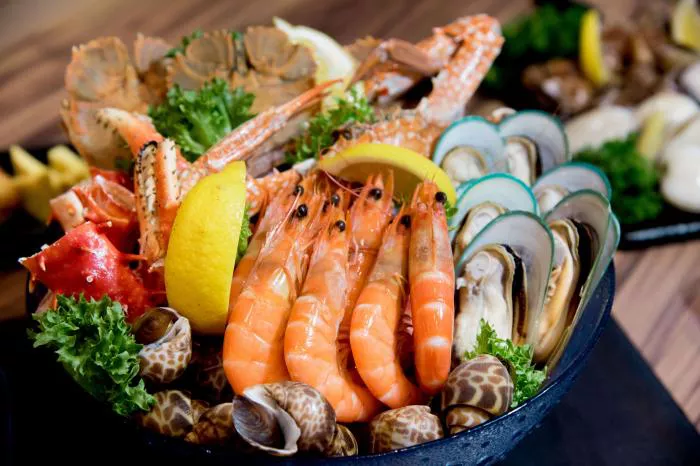Breastfeeding is a vital time for mothers and their babies. What you eat can affect your milk and your baby’s health. Seafood is often a topic of concern for breastfeeding mothers. Many wonder if it’s safe to eat seafood while breastfeeding and which types are best. This article explores the safety, benefits, and risks of consuming seafood while breastfeeding.
Nutritional Benefits of Seafood
Seafood is packed with important nutrients. It is a great source of protein, omega-3 fatty acids, vitamins, and minerals. These nutrients are essential for both the mother and the baby.
Omega-3 Fatty Acids
One of the standout benefits of seafood is its omega-3 fatty acid content. Omega-3s are important for brain development in babies. They also support heart health for mothers. Eating seafood that is rich in omega-3s can help improve your milk’s nutritional quality.
Fish like salmon, sardines, and mackerel are excellent sources of omega-3s. Including these types of fish in your diet can provide significant health benefits for both you and your baby.
Protein and Other Nutrients
Seafood is an excellent source of high-quality protein. Protein is crucial for healing and recovery after childbirth. It also helps maintain energy levels while breastfeeding.
In addition to protein, seafood contains vitamins like B12 and D, as well as important minerals such as iodine and selenium. These nutrients are vital for the health of both mother and child.
Safety Considerations When Eating Seafood
While seafood offers many health benefits, there are important safety considerations for breastfeeding mothers. Some types of seafood can contain harmful substances.
Mercury Levels in Fish
One of the biggest concerns with seafood is mercury. Mercury is a toxic metal that can harm brain development in infants. Some fish have higher mercury levels than others.
Large fish like shark, swordfish, and king mackerel tend to have the highest mercury levels. It is best to avoid these types of fish while breastfeeding. Instead, focus on low-mercury options.
Low-Mercury Fish Choices
Safe options include:
Salmon
Sardines
Anchovies
Trout
Catfish
Shrimp
These fish are lower in mercury and can be safely included in your diet.
Shellfish and Other Seafood
Shellfish like shrimp, crab, and clams are generally safe to eat while breastfeeding. They are low in mercury and high in protein. However, be cautious of your source. Ensure that any shellfish is cooked thoroughly to avoid foodborne illnesses.
Allergies and Sensitivities
Some babies may be sensitive to seafood. If you have a family history of seafood allergies, be cautious. Watch for signs of allergies in your baby, such as rashes, digestive problems, or respiratory issues.
Introducing Seafood Gradually
If you are unsure about introducing seafood into your diet, start slowly. Begin with small amounts and monitor your baby’s reactions. If you notice any changes in behavior or health, consult your pediatrician.
Cooking and Preparing Seafood Safely
How you prepare seafood is also important. Proper cooking methods can reduce the risk of foodborne illnesses.
Cooking Methods
Grilling: Grilling seafood is a healthy option. It enhances the flavor without adding unhealthy fats.
Baking: Baking is another healthy way to prepare seafood. It allows you to keep the fish moist without extra oil.
Steaming: Steaming preserves the nutrients in seafood while keeping it tender and flavorful.
Avoid frying seafood, as it can add unhealthy fats and calories.
Storing Seafood
Ensure that you store seafood properly to prevent spoilage. Keep seafood in the refrigerator and consume it within a couple of days. If you freeze seafood, make sure it is well-sealed to maintain freshness.
Balance in Your Diet
While seafood is nutritious, it should be part of a balanced diet. Eating a variety of foods is essential for your health and your baby’s health.
Other Protein Sources
In addition to seafood, include other protein sources in your diet. Options like lean meats, poultry, eggs, dairy, beans, and legumes are all excellent choices. This variety will provide essential nutrients and help maintain your energy levels.
Fruits and Vegetables
Don’t forget to incorporate plenty of fruits and vegetables. They provide important vitamins, minerals, and fiber. Aim for a colorful plate to ensure you are getting a wide range of nutrients.
See also: Is It Safe To Eat Chocolate While Breastfeeding
Conclusion
In conclusion, seafood can be a healthy addition to your diet while breastfeeding. It provides essential nutrients, including omega-3 fatty acids, protein, and vitamins. However, it is important to choose low-mercury options and prepare seafood safely.
Monitor your baby for any signs of allergies and introduce seafood gradually. If you have concerns, consult your healthcare provider. By making informed choices, you can enjoy the benefits of seafood while ensuring the health of both you and your baby.
Breastfeeding is a special time, and your diet plays a significant role. With careful planning, you can enjoy a variety of foods, including nutritious seafood, while providing the best for your child. Embrace this journey and nourish both yourself and your baby with a well-rounded diet!
Related topics:


